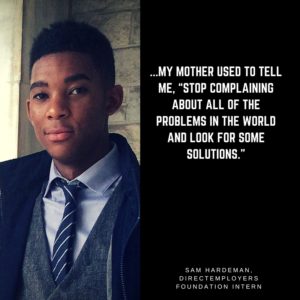As many employers continue to develop an inclusive culture, it’s important to consider what diversity means to a multi-generational workforce, including the next generation of talent.
I asked Sam Hardeman, a high school senior who is currently interning with the DirectEmployers Foundation and is a previous participant in the Youth Enhancement Summer Program (STEM YES!), to reflect on what diversity means to him, and this was his response:

I would say that the diversity must be in the schools, but at my own prestigious Catholic school in Indianapolis, Indiana, the numbers of ethnic diversity aren’t any better. Although our school does demonstrate an almost unparalleled amount of intellectual diversity through dialogue between students and between teachers, we are still lacking all of the colors that make up our great nation.
Nearly 50 years after the death of Martin Luther King, people are still misunderstanding what his view on diversity meant. Diversity has become a way to describe the cultural or ethnic variety in an organization or group, but this definition paints a picture of collaboration and mutual growth that is not present in our world today. Webster’s Dictionary definition of diversity is, “the condition of having or being composed of differing elements: the inclusion of different types of people (as people of different races or cultures) in a group or organization” and even this definition falls short of the significance we give the word when we use it in context. This is all true in society, however just like the definitions, we fall short because the inclusion and involvement between the different cultures or races ends here. There is no collaboration and when there are instances of exchanging principles or ideas, these conversations always evolve into arguments, with each side entrenched by the problems of past generations; thus hindering any societal or intellectual growth.
Even when we look to our schools to see the evidence of a brighter integrated future we are left with the same truth that has been self-evident all throughout American history. The problem is that people think that because they put a group of dogs and a group of cats together in a room they will settle their issues and come together as one. However, as seen in many institutions and workplace environments across the country, people refuse to put their own biases aside to grow. Even though most would say that the diversity must be in the schools, this is not the case; even at my own Jesuit high school, the numbers of ethnic diversity aren’t any better than the national average found in workplaces.
But my mother used to tell me, “stop complaining about all of the problems in the world and look for some solutions.” So we can continue to speculate about all of the problems surrounding diversity in our society, or we can use all of the knowledge we have been given from past generations in order to implement a solution. The solution has been right in front of us this whole time but we continue to miss it. We cannot hope for change if we do not actively want to change ourselves; and change begins and ends with each and every one of us.

